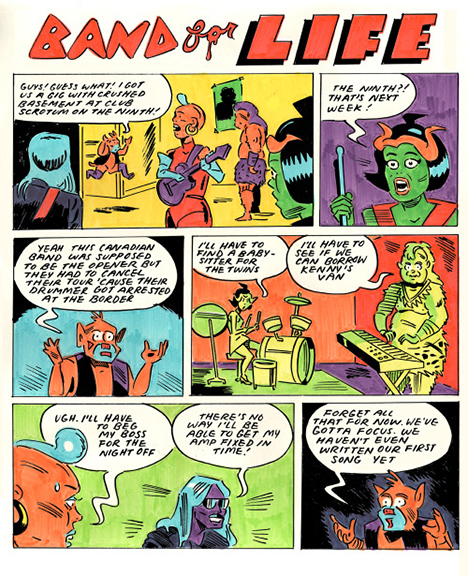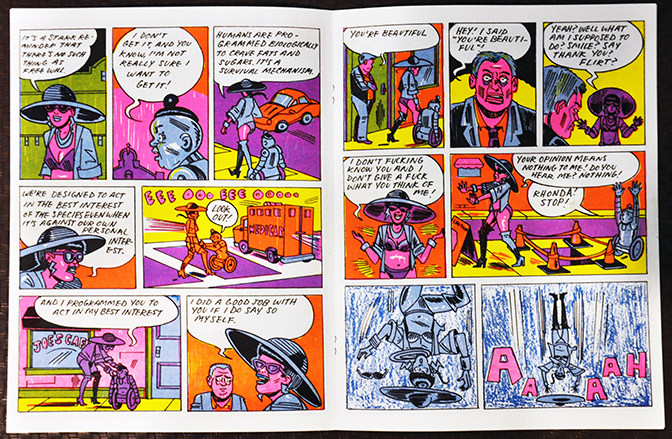Whether instigating chaos at a local DIY Noise concert or drawing comics with live raccoons wandering about in the next room in Chicago’s west Pilsen neighborhood, Anya Davidson has carved out an unmistakable voice that is fiercely brazen, darkly humorous, and reminiscent of a long lineage of significant comics innovators. Recently, The COMP Magazine caught up with Davidson to discuss her forthcoming book, “Band For Life”, some of the artists and life events that have informed her working method, her tactile approach to creating comics, and the role of music in her aesthetic practice.

Anya Davidson, Best American Comics 2015 (endpapers), Houghton Mifflin Harcourt Publishing, 2015
How about we start with a little background? You were raised in rural Canada. I believe on Prince Edward Island? Then moved to Tennessee for High School and eventually landed in Chicago. How did these places inform your current comic pursuits?
That’s a big question! Growing up in a rural area gave me a deep love and appreciation for the natural world. My parents divorced when I was 14 and that’s why my mom and I moved to Nashville, which is where her family lives. That was a huge culture shock for me. Music and books were my life raft, and they continue to be. Chicago was an escape. I think that’s why the city figures so predominantly in my work. I love the diversity, the freedom of expression here. My Chicago friends-the artists and musicians I met when I moved here for school-exposed me to a world I never knew existed and they play a huge role in my work.

Anya Davidson, School Spirits (cover), PictureBox, 2013

Anya Davidson, School Spirits (interior pages), PictureBox, 2013
You’re also a musician. There are numerous references to this medium in your comics. What role does music play? Do you recall your first music experience? How has your taste in music changed over time?
Playing music is an immediately cathartic experience. Cartooning is a slow process. It usually takes me an entire day of work to draw a single page. And then it takes months or years to get a book ready for publication. I think a lot of cartoonists enjoy playing music for the release. My first true musical loves (after oldies on the radio) were punk and grunge, and my first experiences with live music were punk shows that were held in a little art gallery on Prince Edward Island. There was a band called Hideous Progeny that used to play often, comprising a skinny young man in a striped shirt and black jeans playing guitar and his awesome, witchy girlfriend playing a drum. I still have their tape. It’s called “The Scarecrow Told Me Stories.” I love all genres of music and I listen to a lot more 70’s hard rock than I used to. I don’t think I would’ve liked Uriah Heep, for instance, as a teen.

Anya Davidson, Band For Life (cover), Fantagraphics Books, 2016

Anya Davidson, Band for Life (in-process), page 1, 2014
Your new book, “Band for Life”, to be published by Fantagraphics is scheduled for release in September. Can you share with us an introduction on your intent and process in the creation of this ambition work?
I told my publisher that my intent was to “write a love letter” to people who are engaged in creative pursuits with no hope of a financial reward. The book is in no way autobiographical, but I did find ways to include many of my own experiences and the experiences of my friends in the strips. It was very therapeutic for me. My first book was a bit of an attempt to grapple with and make sense of my teen years, and this book reckons with a lot of my twenties.

Anya Davidson, Head Shrinka (cover), 2015
Your aesthetic references a punk sensibility by way of Gary Panter and Johnny Ryan. There’s also a raw grittiness that stretches back to early Punk zines. Using these foundations are there specific ideas or aspects related to the medium that you hope to expand upon with your work?
The reason punk was and still is so fundamental to my identity is that it said “you don’t have to be able to play an instrument to be in a band, you don’t have to be good at drawing to make a comic, you don’t have to write well to make a zine. You have permisision do do whatever the hell you want as long as you have the interest and the passion.” That was so huge for me. It gave me the freedom to try my hand at many creative endeavors without fear of failure. I don’t know if that really answers the question…

Anya Davidson, Head Shrinka (interior pages), 2015
You work in a traditional tactile process, laying out pages in a similar manner to old school cartoonists. Can you share your process? What gets you excited about visual sequential narrative?
I do a really rough page layout first, and just kind of compose the page. Then, with a light-box, I do tighter pencils and then inks on separate sheets of paper. I stopped inking on the same page as my pencils because I hated erasing the pencils when I was finished. I can keep everything cleaner that way. And I love the freedom to just do a crazy rough sketch without fretting about the end result. So much excites me about visual sequential narrative, primarily the fact that i never had to choose whether to be a painter or a writer. I get to be mediocre at both (just kidding!)

Anya Davidson, Biobuddy (cover), 2014
You also hold a fondness for a number of old comic masters like Wally Wood, Harvey Kurtzman, Milt Gross and R. Crumb? What draws you to these artists or others?
I actually am taking visual cues from a lot of earlier American cartoonists, such as John Stanley, who did a strip I love called Melvin Monster, Dan Decarlo who drew Archie comics for many years, and the artists associated with E.C comics, specifically Harvey Kurtzman, Will Elder, Jack Davis and Wally Wood. I’ll never hold a candle to those guys technically, but I’m very taken with the spirit of their work. Those comics had (and still have) huge entertainment value. My aim is primarily to tell compelling stories in a visual style that’s clear and engaging. So I guess my primary ambition is as a storyteller. I want to take some cues from those all-time great artists, but always strive to tell more interesting, more complex stories. That’s the beauty of Crumb. He built on the work of artists who came before, but he told personal stories and aired out all of his most sordid thoughts and dirty laundry in a way no one really had before.

Anya Davidson, Gloom Planet (cover), 2015
So, in addition to “Band for Life”, what else do you have planned for the remainder of 2016?
I have another book called “Lovers in the Garden” that’ll be coming out in October or November with Retrofit comics. And I’m in a new band I’m really excited about, but we don’t have a name yet.

Anya Davidson, Gloom Planet (interior pages), 2015
For additional information on the comics and music of Anya Davidson, please check out:
Anya Davidson – http://anyadavidson.com/
Fantagraphics Books – http://www.fantagraphics.com/artists/anya-davidson/
Vice Magazine – http://www.vice.com/tag/anya%20davidson
Comics Beat – http://www.comicsbeat.com/anya-davidsons-band-for-life-to-be-collected/
Bad at Sports – http://badatsports.com/2013/meanwhile-anya-davidson/

Anya Davidson, artist and musician, Chicago, IL, 2015
Artist interview and portrait by Chester Alamo-Costello


